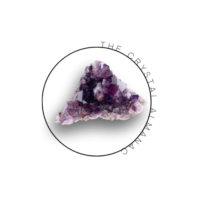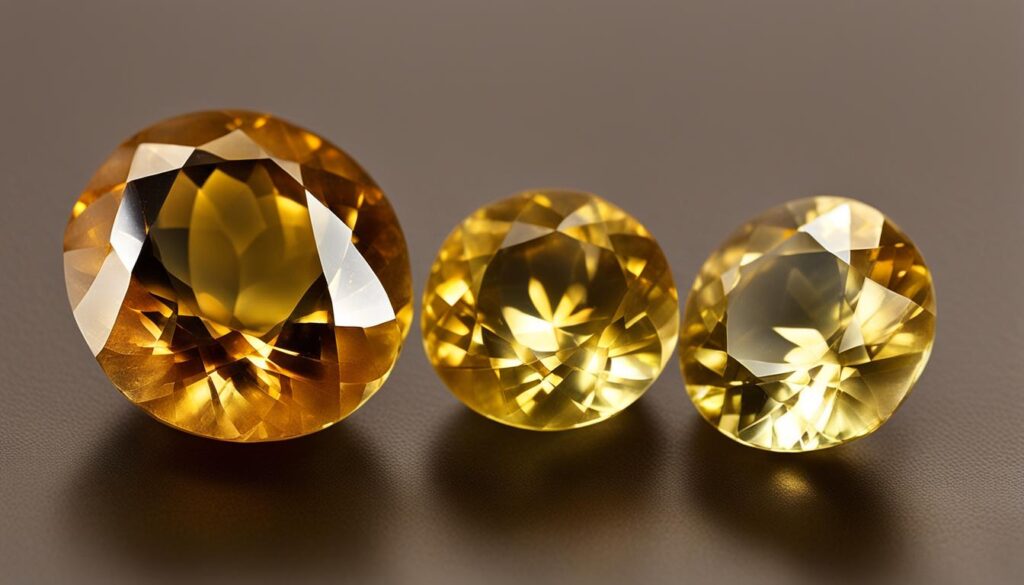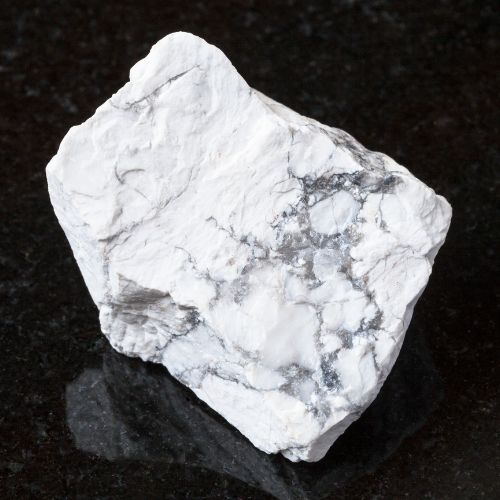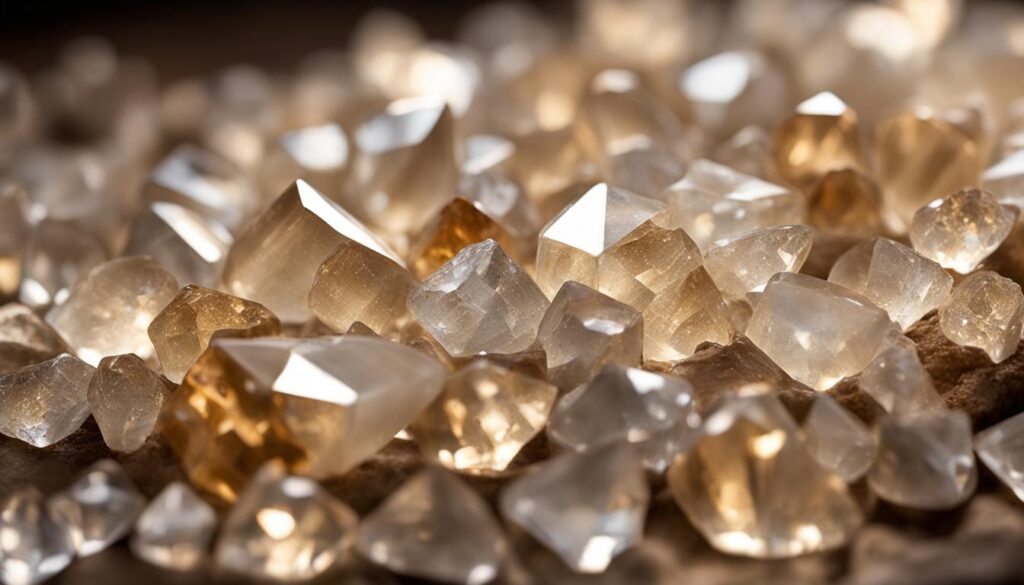Citrine is a popular crystal renowned for its sunny energy and ability to attract prosperity and abundance. However, it’s essential to discern whether the Citrine you possess is natural or heat treated. With approximately 95% of Citrine on the market being heat treated Amethyst, it’s crucial to understand the distinctions between authentic Citrine crystals and their heat treated counterparts to ensure you are getting the genuine article. Let’s explore how to distinguish between natural and heat treated Citrine.
Key Takeaways:
- When purchasing Citrine, there is a high chance of it being heat treated rather than natural.
- Natural Citrine ranges in color from pale yellow to smoky yellow, while heat treated Citrine often exhibits a burnt orange hue.
- Crystalline formations differ between natural and heat treated Citrine, with natural Citrine appearing as single crystals or small clusters and heat treated Citrine often being found in geode formations.
- Identifying characteristics of heat treated Citrine include intense color at the tips, crumbly texture, and cluster formations.
- Fake Citrine may be made of glass or dyed clear stones and can be identified by the presence of bubbles, lack of color banding, and a cooler touch.
The Main Color of Natural Citrine
Natural Citrine comes in a range of colors, from very pale yellow to a deeper, smoky yellow hue. It is important to note that natural Citrine is rarely a deep burnt yellow-orange color, which is commonly seen in heat treated Citrine. The color of natural Citrine can also have slight variations within the crystal, giving it a unique and organic appearance.
Unlike heat treated Citrine, which often has an opaque white base, natural Citrine typically retains its clarity and transparency. This distinction in base color can help differentiate between the two types of Citrine. Natural Citrine also tends to have a vibrant and lively energy, further emphasizing its authenticity.
Distinguishing Characteristics of Natural Citrine
- Range of colors from pale yellow to smoky yellow
- Absence of deep burnt yellow-orange color
- Transparent and clear appearance
- Vibrant and lively energy
By closely examining the main color and base color of a Citrine crystal, it is possible to determine whether it is natural or heat treated. This knowledge enables crystal enthusiasts and buyers to make informed choices and appreciate the beauty and authenticity of natural Citrine.
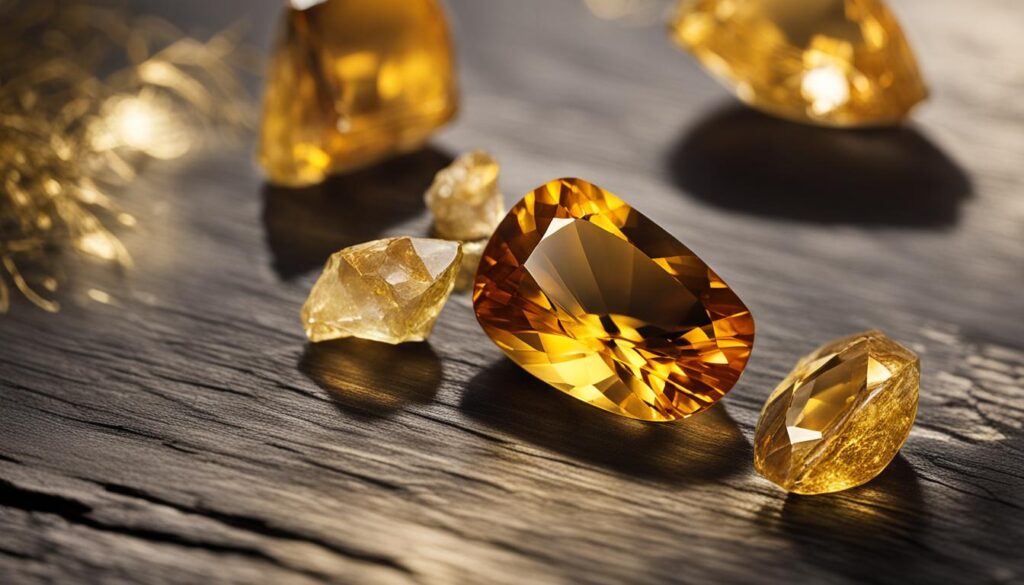
Crystal Formation of Natural Citrine
When it comes to distinguishing natural citrine from heat treated citrine, one of the key factors to consider is the crystal formation. Natural citrine crystals tend to grow in single crystals or small clusters of a few crystals. These formations are relatively rare and showcase the unique beauty of natural citrine.
On the other hand, heat treated citrine is often found in geodes of varying sizes, resembling orange amethyst. These geode formations are more common and can easily be identified as heat treated citrine. The crystal formations of natural citrine and heat treated citrine are distinct, making it easier to differentiate between the two.
To further illustrate the difference, here is a comparison table that highlights the crystal formations of natural citrine and heat treated citrine:
| Natural Citrine | Heat Treated Citrine |
|---|---|
| Single crystals or small clusters | Geode formations |
| Rare and unique | More common |
By examining the crystal formation, you can easily identify whether a citrine crystal is natural or heat treated. This knowledge allows you to make informed decisions when purchasing citrine and ensures that you are getting the genuine, natural crystal.
Identifying Heat Treated Citrine
In order to determine whether a Citrine crystal is natural or heat treated, it is important to look for specific characteristics that can help distinguish between the two. One of the key factors to consider is the color intensity. Heat treated Citrine often exhibits vibrant orange and red hues, particularly at the tips of the crystal. This intense coloration is a result of the heating process and is less commonly seen in natural Citrine.
Another distinguishing feature is the texture of the crystal. Heat treated Citrine can have a crumbly or somewhat brittle texture, whereas natural Citrine tends to be more stable. This difference in texture can be attributed to the structural changes that occur during the heating process. By feeling the crystal and observing any signs of brittleness, it is possible to identify whether it has been heat treated.
In terms of formation, heat treated Citrine is often found in cluster formations. This is because it originates from heated Amethyst geodes, which naturally form in clusters. On the other hand, natural Citrine crystals tend to grow as single crystals or in small clusters of a few crystals. By examining the formation of the crystal, it is possible to determine whether it is more likely to be heat treated or natural.
| Characteristics | Heat Treated Citrine | Natural Citrine |
|---|---|---|
| Color Intensity | Intense orange and red hues, particularly at tips | Rarely exhibits deep burnt yellow-orange color |
| Texture | Crumbly or brittle | More stable |
| Formation | Cluster formations | Single crystals or small clusters |
By considering these key characteristics and examining the crystal closely, it is possible to identify whether a Citrine crystal is heat treated or natural. The distinct color intensity, texture, and formation can provide valuable insights into the crystal’s origin and authenticity.
Fake Citrine: How to Spot Inauthentic Gems
When shopping for Citrine crystals, it’s important to be aware of the possibility of fake stones on the market. Fake Citrine can come in the form of glass or dyed clear stones, masquerading as the genuine article. By knowing what to look for, you can avoid purchasing counterfeit Citrine and ensure that you’re getting the real deal.
Identifying Glass Citrine
Glass Citrine is a common fake in the crystal market. One telltale sign of glass is the presence of bubbles within the stone. Real Citrine, on the other hand, does not have bubbles. Additionally, glass may not exhibit color banding, a phenomenon commonly found in natural gemstones. Another clue is that glass tends to feel cooler to the touch, while genuine Citrine feels warmer. Faceted glass may have more rounded edges, while real Citrine has sharp edges. These distinguishing characteristics can help you spot glass Citrine and avoid being deceived.
Detecting Dyed Citrine
Dyed Citrine is another form of fake Citrine that you may encounter. Dyed stones are typically clear quartz crystals that have been artificially colored to mimic the appearance of Citrine. One way to detect dyed Citrine is to examine the color closely. If the color appears too vibrant or unusually uniform, it may be a sign of dye. Additionally, inspect the stone for any color bleeding or uneven dye distribution. Dyed Citrine may also have an artificial scent or residue from the dyeing process. By being vigilant and observant, you can spot dyed Citrine and ensure that you’re purchasing genuine crystals.
| Characteristics | Genuine Citrine | Glass Citrine | Dyed Citrine |
|---|---|---|---|
| Bubbles | No | Yes | No |
| Color Banding | Present | Absent | Absent |
| Texture | Smooth | Cool to the touch | Smooth |
| Edges | Sharp | Rounded | Sharp |
| Scent/Residue | N/A | N/A | Possible |
By familiarizing yourself with the characteristics of fake Citrine, such as glass and dyed stones, you can confidently identify and avoid counterfeit crystals. Remember to purchase from reputable crystal sellers and ask about the authenticity of the Citrine they are selling. With a discerning eye and knowledge of what to look for, you can enjoy the beauty and energy of genuine Citrine in your crystal collection.
Rarity and Value of Natural Citrine
When it comes to Citrine, natural specimens are highly prized for their rarity and unique properties. Unlike the majority of Citrine on the market, which is heat treated Amethyst, genuine natural Citrine is considered rare and, as a result, holds a higher value in the crystal market.
Natural Citrine’s scarcity stems from its limited availability in comparison to its heat treated counterpart. Only a small percentage of Citrine crystals occur naturally, making them more sought after by collectors and crystal enthusiasts.
The authentic energy and connection to the Earth that natural Citrine possesses also contribute to its desirability. Many individuals prefer natural Citrine for its believed higher vibrational energy and cleansing properties.
| Comparison | Natural Citrine | Heat Treated Citrine |
|---|---|---|
| Origin | Occurs naturally | Result of heating Amethyst |
| Rarity | Considered rare | More readily available |
| Value | Higher | Lower |
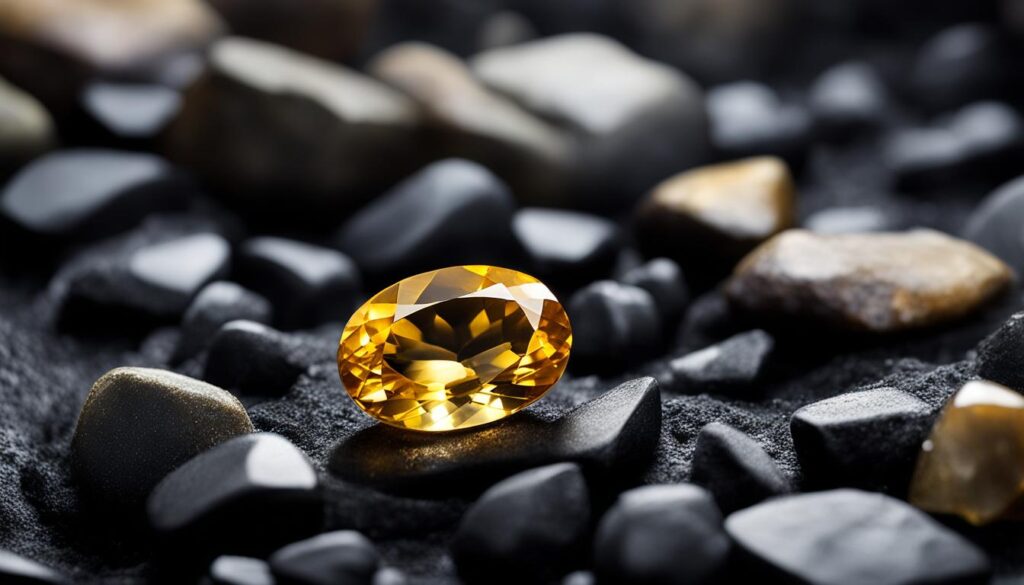
When purchasing Citrine, it’s essential to be aware of the distinction between natural and heat treated varieties. To ensure you are buying genuine natural Citrine, it is recommended to purchase from reputable crystal sellers and inquire about the origin and authenticity of the crystal. Certified laboratory testing can also provide confirmation of a crystal’s authenticity.
Use of Heat Treated Citrine in Healing
Heat treated Citrine is widely used in the field of crystal healing due to its energetic properties and ability to promote positive thinking and prosperity. While some crystal healers prefer natural Citrine for its believed higher vibrational energy and cleansing properties, heat treated Citrine still holds value in various healing practices.
The energy of heat treated Citrine is believed to stimulate the Solar Plexus chakra, which is associated with personal power, confidence, and abundance. It is often used to enhance self-esteem, motivation, and manifestation of goals. Heat treated Citrine is also known to promote positive energy, dispel negativity, and attract success and wealth.
When comparing natural Citrine and heat treated Citrine in healing, it is important to consider personal experiences and preferences. Both variations of Citrine can provide energetic support and contribute to overall well-being. Factors such as availability, cost, and individual resonance with the crystal should be taken into account when choosing between natural or heat treated Citrine for healing purposes.
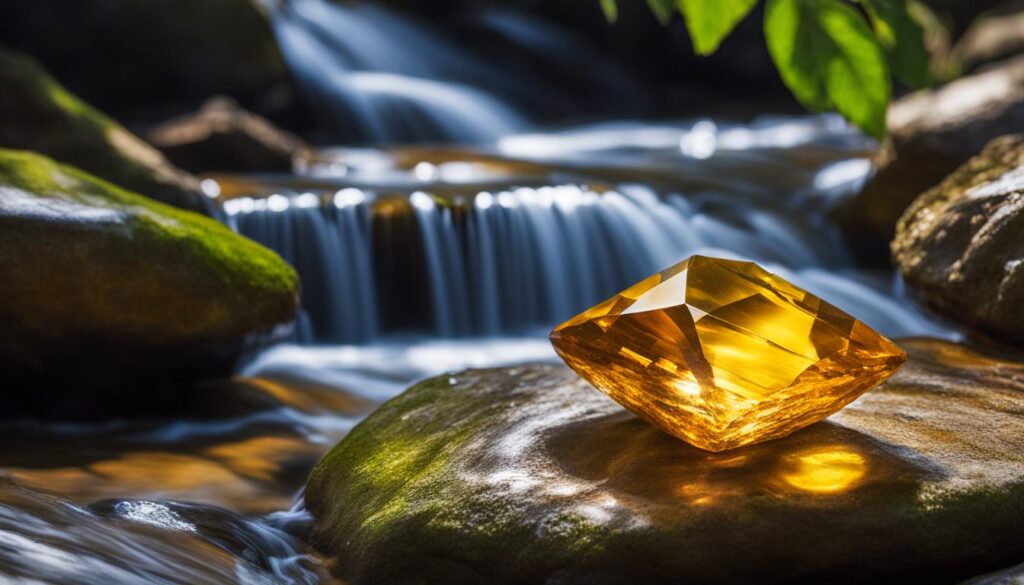
Key Points:
- Heat treated Citrine is used in crystal healing for prosperity, positive thinking, and Solar Plexus chakra work.
- Natural Citrine is believed to have higher vibrational energy and cleansing properties.
- Choosing between heat treated and natural Citrine in healing depends on personal preference and individual experiences.
Table: Comparing Natural Citrine and Heat Treated Citrine in Healing
| Aspect | Natural Citrine | Heat Treated Citrine |
|---|---|---|
| Energetic Properties | Believed to have higher vibrational energy and cleansing properties | Stimulates Solar Plexus chakra, enhances self-esteem and motivation |
| Availability | Rare and more expensive | Readily available |
| Cost | Higher | Lower |
| Resonance | May resonate more strongly with individuals seeking higher vibrations | May resonate more with individuals in need of Solar Plexus chakra support |
Where to Find Authentic Citrine
If you’re in search of authentic Citrine, it’s important to know where to look. With so many options available, finding reputable crystal sellers can ensure that you are buying genuine Citrine crystals.
One way to find reputable sellers is by doing thorough research. Look for sellers with a strong online presence and positive customer reviews. Websites that provide detailed information about their products, including the origin and authenticity of their Citrine, are a good place to start.
Another option is to buy from physical crystal stores that have established a reputation for selling authentic crystals. These stores often have knowledgeable staff who can provide guidance and answer any questions you may have about the authenticity of the Citrine they sell.
For added assurance, consider purchasing from sellers who offer certified laboratory testing. This ensures that the Citrine has undergone professional evaluation and guarantees its authenticity. Certified laboratory testing provides peace of mind and confidence in the quality of the crystal you are purchasing.
FAQ
What is the difference between natural Citrine and heat treated Citrine?
Natural Citrine is formed in the Earth with a range of pale to smoky yellow shades, while heat treated Citrine is actually Amethyst that has been heated to create an orange color.
How can I tell if a Citrine crystal is natural or heat treated?
Look for the main color of the crystal – natural Citrine is rarely a deep burnt yellow-orange. Also, check the base color, as heat treated Citrine often has an opaque white base. Crystal formation can also be a clue, as natural Citrine grows in single crystals or small clusters, while heat treated Citrine is commonly found in geode formations.
What are the identifying characteristics of heat treated Citrine?
Heat treated Citrine tends to have more intense color at the tips, ranging from bright yellow to orange or red. It may also have a crumbly texture and is often found in cluster formations.
How can I recognize fake Citrine?
Fake Citrine can be made of glass or dyed clear stones. Look for bubbles in the glass, lack of color banding, and a cooler temperature compared to genuine Citrine. Faceted glass may also have more rounded edges.
Why is natural Citrine more valuable than heat treated Citrine?
Natural Citrine is considered rare and has unique properties that make it more sought after by collectors. Its scarcity contributes to its higher value in the crystal market.
Can heat treated Citrine be used for healing purposes?
Yes, heat treated Citrine still possesses the energy and properties associated with Citrine. However, some crystal healers prefer natural Citrine for its believed higher vibrational energy and cleansing properties.
Where can I find authentic Citrine?
It is important to purchase Citrine from reputable crystal sellers. Ask about the origin and authenticity of the crystal. Certified laboratory testing can also provide confirmation. Trusted crystal suppliers, both online and in physical stores, are more likely to have genuine, natural Citrine available.
